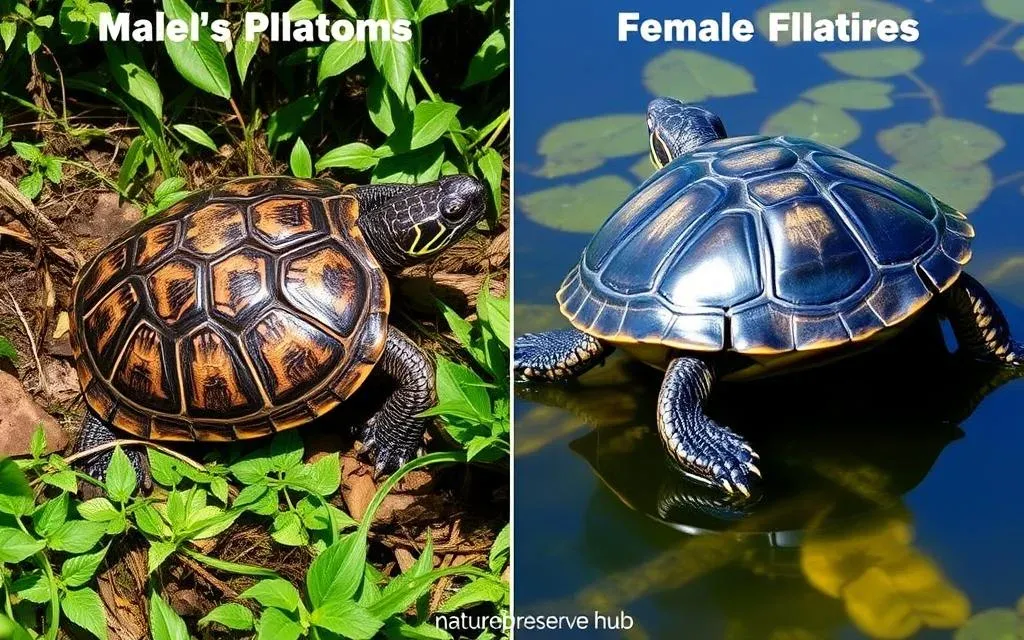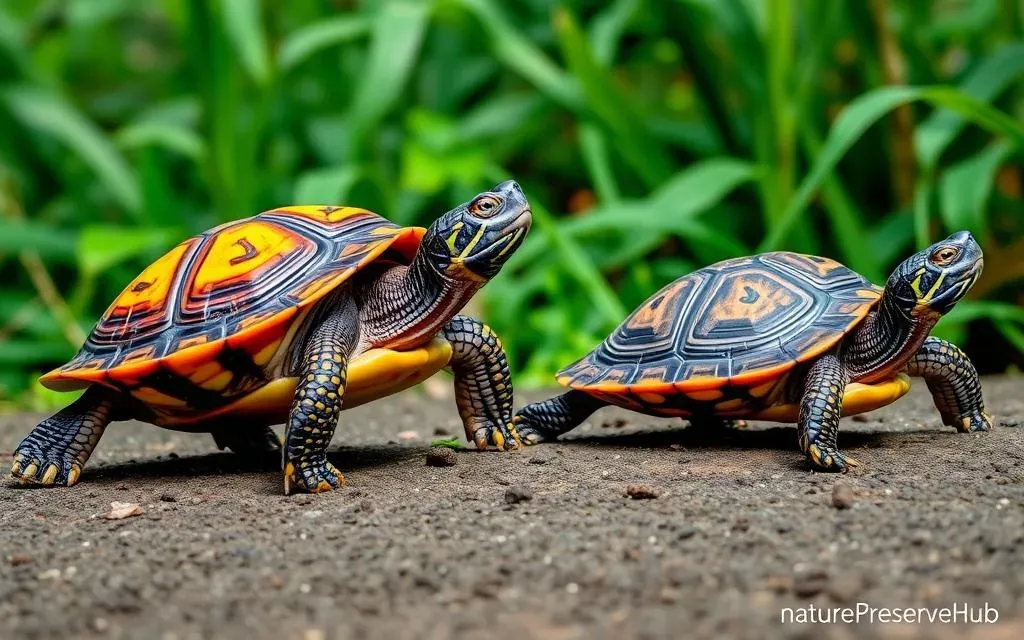Learning how to tell if a turtle is male or female can be really interesting. We’re here to share tips and visual clues to help you figure it out. This guide will cover the main physical and behavioral differences between males and females. We’ll also look at how age and species can affect identification.
Knowing your turtle’s gender is important for their care and health. By understanding the differences between males and females, you can make sure your pet gets the right care. Let’s explore how to identify a turtle’s gender together!
Table of Contents
ToggleUnderstanding Sexual Dimorphism in Turtles
Turtles show clear differences in looks and behavior between males and females. These differences are key for taking good care of them, breeding, and managing their homes.
Physical and Behavioral Differences
Male and female turtles have distinct traits. Males usually have longer, thicker tails and bigger openings where waste comes out. Some turtles also have different shaped and sized shells, with males having longer and more curved ones.
Behaviorally, males are often more aggressive and defend their territory. They do things like bob their heads and hit each other with their shells during mating. Females are usually calmer and focus on laying eggs.
Why It’s Important to Identify Gender
Knowing a turtle’s gender is vital for many reasons. It helps in giving them the right food, home, and environment. It’s also key for breeding programs, making sure the right turtles are paired.
For researchers and those managing turtle populations, knowing about sexual dimorphism is crucial. Being able to sex turtles correctly helps in understanding their behavior and how to protect them.
Examining Shell Characteristics
Looking closely at a turtle’s shell can tell us a lot about its gender. The shape and size of the shell show clear differences between males and females. This makes it easy to tell them apart.
Male vs. Female Shell Shapes
Male turtles have a shell that’s a bit more domed or convex. It has a more pronounced curve on top. On the other hand, female turtles have flatter and more streamlined shells. They look more elongated.
This difference is really clear in aquatic turtles. The male’s arched shell helps him during mating and swimming.
Another difference is the shell’s width. Male turtles usually have wider, broader shells. This makes them more stable and strong. It helps them compete for mates and protect their territory.
| Shell Characteristic | Male Turtle | Female Turtle |
|---|---|---|
| Shell Shape | Slightly more domed or convex | Flatter and more streamlined |
| Shell Width | Wider and broader | Narrower and more elongated |
By looking at a turtle’s shell shape and size, you can usually tell its gender. This is very useful for taking good care of your pet turtle.
Observing Tail and Cloaca Differences
Determining a turtle’s gender is easy with a close look at its tail and cloaca. These parts tell you if it’s a boy or a girl turtle.
Male turtles have tails that are long, thick, and pointy. Their cloaca is also far from the body, often sticking out past the shell’s edge. On the other hand, female turtles have tails that are short and thin. Their cloaca is closer to their body.
Let’s dive deeper into these differences:
| Characteristic | Male Turtle | Female Turtle |
|---|---|---|
| Tail Shape | Longer, thicker, and more tapered | Shorter, slimmer |
| Cloaca Position | Located further away from the body | Located closer to the body |
Keep in mind, these are general tips. The specifics can change with different turtle species and individuals. Always check with a pro or trusted sources if you’re trying to figure out a turtle’s gender by its tail and cloaca.
How to Tell If a Turtle is Male or Female
Key Visual Cues to Look For
Learning to tell a turtle’s gender can be exciting for reptile lovers. By knowing the visual signs, you can easily tell if your turtle is male or female. Let’s look at the main physical traits that help tell them apart.
The shape and size of the turtle’s shell are key signs. Males usually have a domed or curved shell, while females have a flatter shell. Also, males often have longer, thicker tails than females.
The position of the cloaca is another clue. This is where the turtle’s digestive, urinary, and reproductive systems meet. In males, the cloaca is near the tail tip. In females, it’s closer to the body.

Size and proportions also matter. Male turtles are usually bigger and more muscular, with longer front claws and thicker necks. Females tend to be slimmer and more petite.
By looking at these signs together, you can better understand your turtle’s gender. Remember, every turtle is different, so if you’re unsure, it’s best to ask a professional for help.
Age and Species-Specific Considerations
Identifying a turtle’s gender depends on its age and species. The methods to tell males from females vary a lot. Knowing how to identify turtle genders helps us get accurate results.
Juvenile turtles are hard to sex because they’re still growing. We look for small clues like tail shape and size. As they get older, telling males from females gets easier.
Also, different turtle species look very different from each other. Some have unique shells or colors that help tell males from females. It’s important to know these differences to sex a turtle correctly.
To be sure about a turtle’s gender, check out resources that explain turtle traits at different ages. By learning about each species, we can sex turtles with confidence.
Identifying a turtle’s gender takes skill and knowledge. By paying attention to the small differences, we learn a lot. This helps us make better decisions about caring for these amazing animals.
Handling Turtles Safely During Identification
When you’re checking your turtle’s gender, it’s important to do it safely. We’ll give you tips on how to handle your pet without harm to you or your turtle.
Best Practices for Proper Handling
When you’re checking your turtle’s gender, be careful and gentle. Here are some tips to keep you and your turtle safe:
- Use gentle, controlled movements when picking up or holding your turtle. Avoid grabbing or squeezing, as this can cause stress and potential injury.
- Support the turtle’s body evenly, with one hand underneath and the other on top, to distribute its weight evenly.
- Keep your turtle close to the ground or a flat surface to minimize the risk of falls or drops.
- Avoid handling your turtle for extended periods, as prolonged restraint can be stressful.
- Wash your hands before and after handling your turtle to maintain proper hygiene and prevent the spread of potential diseases.
By following these proper turtle handling techniques for gender identification, you can safely check your turtle’s sex. It’s key to know how to safely handle turtles for their health and your safety.
Breeding and Nesting Habits
Watching how turtles breed and nest can teach us a lot about their gender. By learning about their unique mating and nesting ways, we can spot their sex more easily.
Recognizing Mating Behaviors
When it’s time to breed, male turtles show off with complex moves to get the females’ attention. They bob their heads, ram their shells, and chase each other underwater. Females, however, just wait for the males to make the first move.
When it comes to nesting, males and females act differently. Females look for the perfect spot to lay their eggs, digging deep burrows. Males don’t help with this important job.
| Mating Behavior | Male Turtles | Female Turtles |
|---|---|---|
| Courtship Displays | Head-bobbing, shell-ramming, underwater chasing | Passive, waiting for male advances |
| Nesting | Do not participate | Search for suitable nesting sites, dig elaborate burrows to lay eggs |
By watching these unique behaviors, you can learn a lot about the turtles you see. This adds to what you know from looking at their physical traits.
Caring for Male and Female Turtles
When caring for turtles, the needs of males and females differ. It’s important to know these differences for the best care. This ensures your pet’s health and happiness.
Habitat and Environment
Male turtles need a big space because they are more active and like to claim their territory. Females might need a bit more room for laying eggs. Both need places to bask, swim, and live in the right temperature and humidity.
Dietary Needs
Male and female turtles eat similarly, but there are some differences. Females need more calcium and protein when they’re breeding. Males eat more to keep up with their active lives.
Behavioral Considerations
- Male turtles can be aggressive and show dominance, especially when mating.
- Females are usually calmer but can be protective of their eggs and nesting spots.
- Setting up the right habitat and adding enrichment can help reduce fights between turtles.
Health and Veterinary Care
Regular check-ups and care are key for all turtles. Females need extra attention during breeding season for egg health issues.
Knowing the special needs of male and female turtles helps you care for them better. This makes a happy and healthy home for your pets.
Conclusion
In this guide, we’ve looked at how to tell if your pet turtle is male or female. We’ve covered the main differences between males and females. This helps us take better care of our turtle friends.
We talked about checking the shell, tail, and cloaca to see the turtle’s gender. We also touched on how age and species matter. Plus, we covered how to handle turtles and understand their breeding habits.
If you love turtles or are just getting started, this guide has given you the tools to know your turtle’s sex. With this knowledge, you can make better care choices. This ensures your turtle lives a happy and healthy life.








